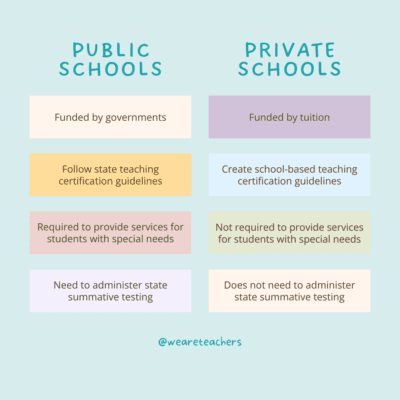

What is it like teaching and learning in a private vs. a public school? Are there more pressures in public schools than private schools? Do private schools require as much teacher training as public schools? What is the pay difference? If you’re thinking about making a change from public school to private school or vice versa, here’s what you need to know.
The main difference between private and public school is that private schools are privately owned and funded without assistance from local, state, or federal governments. Families pay tuition to attend private school. Depending on the private school, tuition can range from hundreds to tens of thousands of dollars per year. Public schools cost nothing for students to attend and are funded by the government.
Teacher pay in private schools really depends on the school and location. Private school teachers work 180 days on average, which is also typical of public school teachers. There are, of course, teacher in-service days, after-school commitments, and other professional obligations that teachers are contracted to be a part of for both public and private schools. The main difference between these obligations, however, is public school teachers usually have a union that allows for bargaining for higher wages or for pay when work goes over contracted hours. Private schools don’t typically have unions, which allows private school administration to incorporate extra work without the pay.
More often than not, you may hear private schools advertising to parents that they offer smaller class sizes, but it really depends on the type of school and how many teachers are at the school. Public schools usually hear the backlash of having overcrowded classrooms. That also depends on where the school is located and the funding the public school has related to teacher salaries.
The government funds public schools and tuition, and donations fund private schools. Because of these budget constraints, private schools may not always be able to offer the extra support to students that public schools provide. This means having speech pathologists, counseling, and extended resource support, for example. The same goes for public schools. If their funding can’t support extra programs, those programs will be cut. In some instances, public schools may not have music, art, or other fine arts classes.
Public schools are accredited by the state board of education, and private schools do not have to be accredited. This means that public schools have to follow state-adopted standards and state-approved curriculum. Depending on the state, public school districts do have local control when it comes to choosing curriculum—it just has to be a part of the state-adopted list. Private schools are vastly different when it comes to curriculum. Since they don’t necessarily have to follow state and federal guidelines, they are open to choose what they teach and which curriculum they use. Private schools have the option, however, to become accredited through different organizations like the Accrediting Commission for Schools (WASC).
Public school teachers must meet all state certification requirements. Since private schools don’t have to answer to the state, teachers don’t necessarily need certification. It is dependent on the private school and their own personal requirements for teachers. Sometimes private schools hire subject-matter experts with advanced degrees in lieu of a teaching license. Each type of private school can create their own requirements for teacher credentialing.
Since private schools don’t have to follow state guidelines, they don’t have to administer any summative assessments mandated by the state or federal governments. This can make it challenging for parents when they’re trying to consider which school to choose for their children because they don’t have any test scores to compare to public schools. This doesn’t mean that private schools don’t use tests, however. They are free to use any type of assessment they think fits their curriculum, students, and school. Public schools are required to administer state and federal assessments because they receive funding from these governments in order to keep their schools running. These assessment results also help schools get additional funds for more support they may need—for example, things like paraprofessional help, additional curriculum, or other government aid.
By law, public schools are required to provide “a free appropriate education to eligible children with disabilities throughout the nation and ensure special education and related services to those children,” according the the Individuals With Disabilities Education Act (IDEA). Public schools offer student services throughout their entire educational career. Private schools may not have the funds to provide these same supports, and they are not required by law to do so. They can even turn students away if they feel they aren’t a good fit for their school. There are some private schools that specialize in instruction for students who need additional support. It’s important to figure out what services are offered.
“I have been teaching in a Catholic school. We follow the Common Core Standards. Our students do take standardized tests every year, but there’s significantly less pressure on the students and teachers as compared to our public school districts.”
ADVERTISEMENT“I worked in a private school for 5 years. Throughout my time there, I saw administration deny admission to students with special needs.”
“I teach in a private school and if I were ever to leave this school, it would be to leave education. I am very happy where I work and consider myself very lucky.”
“Made less pay, no benefits, and an extremely difficult year. No subs for teachers or specials teachers. Very disorganized. Cash flow problems due to lack of enrollment. I wouldn’t do private again. Loved charter schools though!”
“Public schools generally pay better and are way more likely to be unionized. You have way stronger job protection and generally better benefits.”

Because private schools vary so widely from school to school, it can be challenging to make blanket statements about private schools. It’s important to do your research to find out the differences between private and public schools in your area.